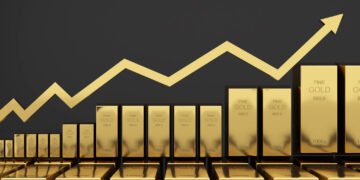In the ever-shifting landscape of global finance, a new trend is emerging that’s catching the eye of savvy investors worldwide: the potential onset of a commodity supercycle. As economic winds change direction, the smart money is starting to pivot from the frothy stock market to the solid ground of commodities.
A Historical Perspective
Commodities have long been the unsung heroes of investment portfolios, often overshadowed by their flashier cousins in the stock market. But history has a way of repeating itself, and if the past is any indication, we might be on the cusp of a major shift.
MN Consultancy’s Michaël van de Poppe points out a striking parallel: “The last [two] times we saw these valuations for commodities was 1971 and 2000.” Both periods preceded significant economic events – the 1970s oil crisis and the dot-com bubble. Today, we’re seeing similar valuation levels, hinting at a possible 10-year bull run in commodities.
This isn’t just idle speculation. Bank of America’s analysts are singing a similar tune, suggesting that we’re at the starting line of a secular bull market in commodities. They’re even proposing a radical shake-up of the traditional 60/40 investment portfolio, advocating for commodities to replace bonds in the “40” portion.
The Numbers Don’t Lie
Let’s talk returns. Over the past four years, commodities have seen a staggering 116% total return. Meanwhile, the U.S. 30-year Treasury bond has taken a 39% hit. Even with falling inflation and a dovish Fed, commodity indexes have been delivering annualized returns between 10% and 14%. It’s hard to argue with those numbers.
What Exactly is a Commodity Supercycle?
Rick Mills, host of the Ahead of the Herd podcast, defines a commodity supercycle as “a period of consistent price increases lasting more than five years, and in some cases, decades.” It’s not just a brief uptick; it’s a fundamental shift in the market dynamics.
These supercycles are born from the mismatch between supply and demand. As economies grow, so does the appetite for commodities. But producers, wary of market volatility, are slow to respond. This lag creates a widening gap between supply and demand, pushing prices higher and higher.
Eventually, the allure of high prices becomes irresistible, and producers ramp up investment. But by the time new supply hits the market, demand has often cooled, leading to oversupply and falling prices. It’s a boom-bust cycle that plays out over years, even decades.
Signs of the Times
So, are we really at the start of a new supercycle? There are compelling signs:
1. Undervaluation: Commodities are currently valued lower than before the dot-com bubble and the 2008 financial crisis.
2. Inflationary Pressures: Despite recent cooling, inflation has left its mark on commodity prices.
3. Green Energy Transition: The push for electrification is driving unprecedented demand for metals like copper, lithium, cobalt, and nickel.
4. Geopolitical Tensions: Global conflicts and trade disputes are disrupting supply chains and creating scarcity.
The Green Energy Factor
This potential supercycle has a unique twist: the global push for sustainability. S&P Global suggests that aggressive commitments to energy transition across G-20 nations could fuel a sustained surge in demand, supply, and prices for key commodities.
Consider these projections:
– Copper demand is set to grow by 53% to 39 million metric tons by 2040.
– Battery metals like lithium could see a seven-fold increase in demand by 2030.
– Overall demand for metals crucial to green technologies could grow fivefold by 2050.
Inflation: The Double-Edged Sword
While central banks have waged war on inflation, bringing it down from 40-year highs, the effects linger. Prices for many goods, including commodities, remain elevated. The S&P GSCI commodities index, while off its 2022 peak, still hovers at levels not seen since 2014.
What’s remarkable is the resilience of commodity prices in the face of high interest rates, elevated bond yields, and a strong dollar – all traditional headwinds for the sector. This suggests underlying strength in the commodity markets.
The Fed Factor
As the Federal Reserve contemplates rate cuts, the stage could be set for a perfect storm in commodity markets. Lower interest rates typically lead to a weaker dollar and lower bond yields – both bullish factors for commodities.
We got a preview of this potential scenario when Fed Chair Powell hinted at future rate cuts. Gold immediately surged to a record $2,531.60 per ounce, with silver breaking through the $30/oz mark. This could be just a taste of what’s to come when rates actually start to fall.
A Unique Supercycle
What sets this potential supercycle apart is the supply-demand dynamics. In previous cycles, surging demand often met reluctant supply. This time, it’s not just about producers being hesitant to invest; in many cases, demand is simply outpacing the ability of supply to keep up.
Take critical metals for the green energy transition. Years of underinvestment have left the industry struggling to meet rapidly growing demand. This isn’t a short-term blip; it’s a structural shift that could support higher prices for years to come.
Investment Implications
For investors, the writing on the wall is clear: commodities deserve a serious look. Whether it’s industrial metals like copper, precious metals like gold and silver, or agricultural commodities, there are opportunities across the board.
But timing, as always, is crucial. While some argue that we’re four years into this bull market, others believe we’re just at the starting line. Either way, the consensus is that there’s still plenty of room to run.
The Bottom Line
As we stand on the precipice of what could be a generational shift in investment trends, the old adage rings true: fortune favors the bold. The commodity markets, long overlooked by many investors, are showing signs of life that can’t be ignored.
Whether you’re a seasoned trader or a novice investor, now might be the time to take a hard look at your portfolio. Are you positioned to benefit from what could be the defining investment trend of the 2020s?
Remember, in the world of investing, being early is often indistinguishable from being wrong. But as the evidence mounts and the narrative gains traction, those who have the foresight to position themselves ahead of the curve may find themselves reaping outsized rewards.
The commodity supercycle isn’t just coming; it may already be here. The question is: are you ready for it?
Acknowledgment: This article was inspired by and includes information from "A decade-long commodity supercycle is just getting started – analysts" published on Kitco.com. For more detailed insights, you can read the full article here.







